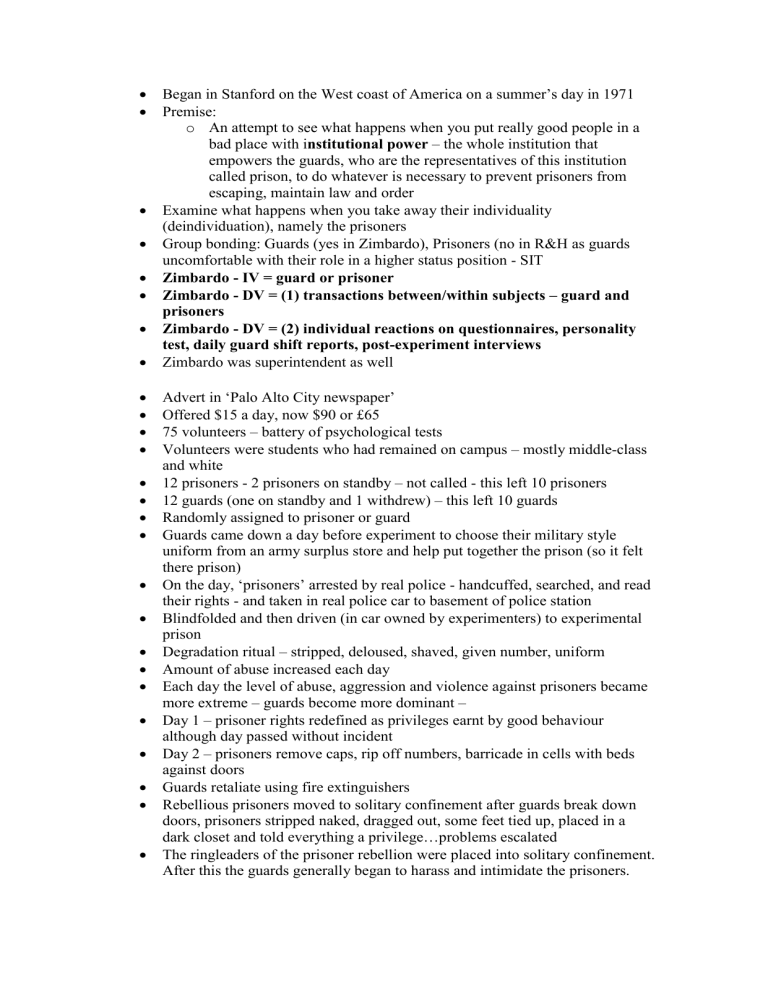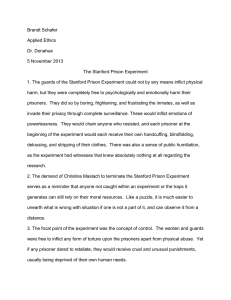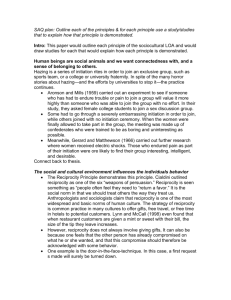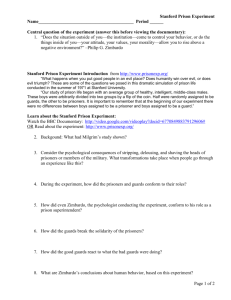
Began in Stanford on the West coast of America on a summer’s day in 1971 Premise: o An attempt to see what happens when you put really good people in a bad place with institutional power – the whole institution that empowers the guards, who are the representatives of this institution called prison, to do whatever is necessary to prevent prisoners from escaping, maintain law and order Examine what happens when you take away their individuality (deindividuation), namely the prisoners Group bonding: Guards (yes in Zimbardo), Prisoners (no in R&H as guards uncomfortable with their role in a higher status position - SIT Zimbardo - IV = guard or prisoner Zimbardo - DV = (1) transactions between/within subjects – guard and prisoners Zimbardo - DV = (2) individual reactions on questionnaires, personality test, daily guard shift reports, post-experiment interviews Zimbardo was superintendent as well Advert in ‘Palo Alto City newspaper’ Offered $15 a day, now $90 or £65 75 volunteers – battery of psychological tests Volunteers were students who had remained on campus – mostly middle-class and white 12 prisoners - 2 prisoners on standby – not called - this left 10 prisoners 12 guards (one on standby and 1 withdrew) – this left 10 guards Randomly assigned to prisoner or guard Guards came down a day before experiment to choose their military style uniform from an army surplus store and help put together the prison (so it felt there prison) On the day, ‘prisoners’ arrested by real police - handcuffed, searched, and read their rights - and taken in real police car to basement of police station Blindfolded and then driven (in car owned by experimenters) to experimental prison Degradation ritual – stripped, deloused, shaved, given number, uniform Amount of abuse increased each day Each day the level of abuse, aggression and violence against prisoners became more extreme – guards become more dominant – Day 1 – prisoner rights redefined as privileges earnt by good behaviour although day passed without incident Day 2 – prisoners remove caps, rip off numbers, barricade in cells with beds against doors Guards retaliate using fire extinguishers Rebellious prisoners moved to solitary confinement after guards break down doors, prisoners stripped naked, dragged out, some feet tied up, placed in a dark closet and told everything a privilege…problems escalated The ringleaders of the prisoner rebellion were placed into solitary confinement. After this the guards generally began to harass and intimidate the prisoners. One of the three cells was designated as a "privilege cell." The three prisoners least involved in the rebellion were given special privileges. The guards gave them back their uniforms and beds and allowed them to wash their hair and brush their teeth. Privileged prisoners also got to eat special food in the presence of the other prisoners who had temporarily lost the privilege of eating. The effect was to break the solidarity among prisoners (compare to Reicher and Haslam where solidarity of prisoners broke guards) At this point, first prisoner released after 36 hours (early stages of depression) next few days – 3 others leave (emotional disorder) fifth released owing to psychosomatic rash which covered portions of his body New rules…we will treat you as dangerous Guards empowered to do whatever is necessary to prevent escape Get prisoners to clean toilet bowls out with their hands Guards take prisoners’ blankets and put them in dirt and nettles, take hours to clean before they could sleep on them Create a totally, arbitrary environment Guards change to become more dominant, all about Zimbardo aborted the experiment early when Christina Maslach, a graduate student in psychology whom he was dating (and later married), objected to the conditions of the prison after she was introduced to the experiment to conduct interviews. Zimbardo noted that, of more than 50 people who had observed the experiment, Maslach was the only one who questioned its morality. After only six days of a planned two weeks' duration, the experiment was discontinued.






